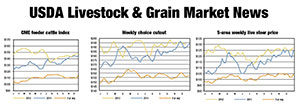Because I lived in a city, it didn’t occur to me that wheat was also being consumed as livestock feed.
A little over 20 years ago, I attended a meat seminar, and the speaker from one of the largest livestock associations showed how the U.S. would grow into the “Butcher Shop,” as he called it, to the world.
Japan would need to buy increasing amounts of beef and pork because of its growing population and lack of land to expand. Oddly enough, China was barely mentioned.
They were considered a country where growth in trade would be mostly industrial.
Pork and dark meat poultry products were meats being sold to Russia, and exports would grow but only in limited amounts because Russia was almost bankrupt, and trading the ruble was difficult on the world currency markets.
Russia moved the U.S. pork belly markets. Pork rumors from time to time moved up and down with positive and negative talk of exports to Russia.
At the time it was believed the USSR would always need U.S. meats and was the best outlet for the lower-priced meat cuts and offal.
It was expected that Russian internal growth in the livestock and grain industries would be slow. At the time, it was thought close to half of all Russian grain after harvest was rotting in the fields due to their poor transportation systems and very little storage.
Did they fool the world? As crude oil prices climbed, they invested in agricultural transportation and storage – and hired experts across the globe specializing in agriculture. Now they are a major competitor in worldwide sales of coarse grains.
A big change came about before and a little after the new millennium. Russia and surrounding former Soviet Union countries became exporters and importers.
The oil industry took them out of bankruptcy, and they are a competitor on the world grain stage. It is a good thing they decided to sell grain versus putting it into livestock production.
However, it will not surprise me to see in the next five years (or less) their livestock production grow, and they will buy less meat on the world marketplace.
When China became a world trade partner, they started aggressively buying soybeans from the U.S. and Brazil to build their livestock industry and to supply vegetable proteins for human consumption.
Shortly before the Beijing Olympics, China became a very aggressive buyer of pork, and a year ago as runaway inflation grew in China, so did the importing of pork.
However, similar to losing status as the bread basket to the world, the U.S. is no longer the butcher shop.
Over the past year, U.S. cattle numbers dropped off the cliff, with massive breeding herd liquidation initially beginning back in late 2009, with the severe drop in cattle prices and reaching drastic reductions last year due to the southwestern U.S. drought.
Brazil, Argentina and Australia have taken away any chance the U.S. could remain butcher shop to the world.
In the next year it is very likely with the downturn in U.S. cattle and hog production, U.S. meat products will slip even farther down the ladder of exports.
Currently, worldwide beef production has seen an uptick in production even though U.S. production has slipped.
Brazil, Argentina and Australia have been doing almost the exact opposite of the U.S. Because of severe droughts in Argentina three to four years ago, they went through a liquidation phase.
But two-and-a-half years ago, when grain production picked up and with the increase in cattle prices beginning late winter of 2010, breeding herds were rebuilt. In Argentina, it was nearly a necessity. Argentines consume beef per capita close to two meals per day.
Brazil’s growth in the beef industry and beef demand has grown for two reasons. Two years ago with the dynamic growth in the Brazilian economy, public demand for choice beef grew.
Two years ago and in early 2012 the U.S. shipped choice beef to Brazil. The cheaper U.S. dollar certainly helped, but now with a cheaper Brazilian real, the growth in grain-fed beef continues.
Feedlots in Brazil are also increasing as grass-fed cattle are moved off areas of land where high-priced grains can be grown at a better rate of return than running cattle on the land.
Will cash cattle prices increase?
At this point, it is almost like flipping a coin. Global demand for meats has started to stagnate. Economic problems in Europe are far from over.
It will take years for U.S. workers going back to work to feel they can buy high-priced muscle cuts over lower-priced ground meat products.
As I have said in past reports, the U.S. has increased almost monthly shipments of “grinding” meat from Australia and with a depleted cow herd, shipments of lower-priced and lower-quality products is likely to continue.
It is also very likely with the build-up of cattle in Brazil and Argentina packers will step up building and renovating slaughter and processing facilities.
At the same time, with the turn-down in U.S. cattle and hog supplies that will continue for at least two and possibly three years for cattle, U.S. packers – as they did three years ago in Argentina – will shut doors on older and slower plants, especially those needing renovations.
In the next two to three years, the lower U.S. production will be offset with growing numbers in South America and Australia.
With increases in grain production in Africa and with increases in dairy in Africa and South America pushed by oil-rich Middle Eastern countries, new supplies of meat will quickly meet demand.
As I often tell people, Warren Buffet didn’t invest in Brasilia Foods, noted as the second-largest beef processor in Brazil, to lose money.
He had the foresight to see demand growing in Brazil and other locations in the world when U.S. numbers were plummeting.
U.S. livestock producers need to take advantage of high-priced U.S. commodity Live Cattle and Feeder Cattle futures ahead of the real possibility of drop in exports from the U.S. and the growth of possible imports into U.S. retail markets. ![]()
Contact market report author Chris Lehner.










